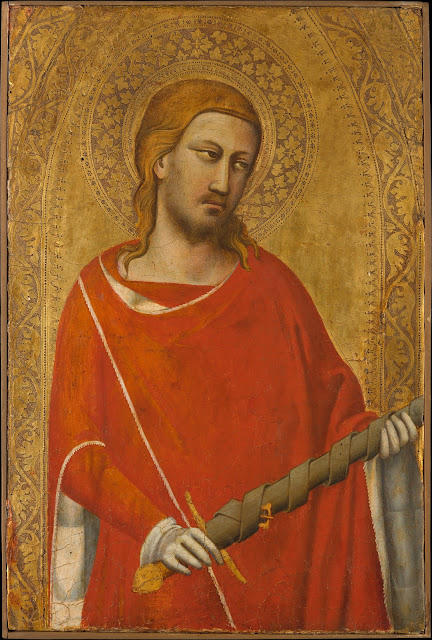Since no work records for Giotto’s workshop have survived it is impossible to identify these artists, but it goes without saying that Giotto must have used assistants, like Taddeo Gaddi, who actually is known to have stayed with Giotto for 24 years, and was in the shop until Giotto’s death.[2] Artists such as these – the Giotteschi- worked on panels signed by Giotto, and have been dismissed as mere imitators of Giotto. Out of the flux and confusion of Giotto’s workshop, a number of major and minor artistic personalities emerge. The camp of the lesser-known is represented by artists like Pacino di Bonaguida, active by 1303, still active after 1320. The diptych[3] attributed to him in the Met shows an early use of Giotto’s themes and forms, although it may owe something to even more obscure masters like the Master of St Cecilia, who takes back into the last days of the dugento.
More famous is Bernardo Daddi (active c. 1320-1348), who preferred painting on panel to frescos. Daddi is best known as the painter between the death of Giotto in 1337 and the Black Death (1348). His set of panels in New York, from a scattered altarpiece,[4] hint at his assimilation of Giotto’s style, though he was also swayed by Sienese art. Maso di Banco, recorded in the 1340s, is also connected with Daddi. According to Cole, it is this artist who understood the motives of Giotto best, and sought to put them into action, although his treatment of architecture is evocative rather than realistic. A stunning example of Maso’s sympathy for Giotto’s aims is also owned by the Met. This panel of St Anthony of Padua[5] unites the qualities of naturalistic expression and stylistic grace, and resembles works that Maso did in the Bardi-di- Bardi Vernio Chapel in Santa Croce, although the influence of Giotto is difficult to judge here because the Maso frescoes in the 1930s were re-painted resulting in what Cole calls a “falsification” of Maso’s work. The last of the Giotto- influenced triad is the aforementioned Taddeo Gaddi officially recorded as a pupil of Giotto’s for 24 years. More will be revealed about him next week when we examine the technique of fresco in more detail.
Some examples of "Giotto's Heirs", all in the Met because it has good high resolution images.
 |
|
Giotto, The
Epiphany, 1320-25, Tempera on wood, gold ground, 45,1 x 43,8 cm
Metropolitan Museum of Art, New York. |
 |
| Ad
Maso di
Banco, Pope St Sylvester's Miracle, about 1340, Fresco, width 534 cm, Cappella
di Bardi di Vernio, Santa Croce, Florence.
|
 |
|
Pacino da Bonaguida, Diptych, one panel, John on Patmos, Madonna and Child, Death of Virgin, tempera on wood,
left wing 61.9 x 40.6 cm; right wing,61.9 x 40 cm, Metropolitan Museum of Art, New York.
|
 |
|
Bernardo Daddi, Saint Reparata before the
Emperor Decius, probably 1336-40, tempera on wood, 32.4 x 40.6 cm, Metropolitan
Museum of Art, New York.
|
 |
|
Maso di Banco, St Anthony of Padua, about 1330,
tempera on wood, gold ground, 74.3 x 40.2 cm, Metropolitan Museum of Art, New
York.
|
 |
|
Taddeo Gaddi, St Julian, 1340s, tempera on wood,
gold ground, 52.7 x 35.2 cm, Metropolitan Museum of Art, New York.
|
[1] Evelyn
Sandberg Vavala, "Giotto's Workshop", The Burlington Magazine for Connoisseurs, Vol. 73, No.
427 (Oct., 1938), pp. 150-154.
[2]
Cole, Giotto and Florentine Painting, 125.
[3] Federico
Zeri, Met catalogue, Italian Paintings: Florentine School, 1971, 17-20.
[4] Zeri, Met catalogue, 26-29.
[5] Zeri, Met catalogue ,
21-2.
No comments:
Post a Comment